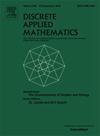Twin-width of graphs with tree-structured decompositions
IF 1
3区 数学
Q3 MATHEMATICS, APPLIED
引用次数: 0
Abstract
The twin-width of a graph measures its distance to co-graphs and generalizes classical width concepts such as tree-width or rank-width. Since its introduction in 2020 (Bonnet et al., 2022), a mass of new results has appeared relating twin-width to group theory, model theory, combinatorial optimization, and structural graph theory.
We take a detailed look at the interplay between the twin-width of a graph and the twin-width of its components under tree-structured decompositions: We prove that the twin-width of a graph of strong tree-width is at most , contrasting nicely with the result of Bonnet and Déprés (2023), which states that twin-width can be exponential in tree-width. Further, we employ the fundamental concept from structural graph theory of decomposing a graph into highly connected components, in order to obtain optimal linear bounds on the twin-width of a graph given the widths of its biconnected components. For triconnected components we obtain a linear upper bound if we add red edges to the components indicating the splits which led to the components. Extending this approach to quasi-4-connectivity, we obtain a quadratic upper bound. Finally, we investigate how the adhesion of a tree decomposition influences the twin-width of the decomposed graph.
求助全文
约1分钟内获得全文
求助全文
来源期刊

Discrete Applied Mathematics
数学-应用数学
CiteScore
2.30
自引率
9.10%
发文量
422
审稿时长
4.5 months
期刊介绍:
The aim of Discrete Applied Mathematics is to bring together research papers in different areas of algorithmic and applicable discrete mathematics as well as applications of combinatorial mathematics to informatics and various areas of science and technology. Contributions presented to the journal can be research papers, short notes, surveys, and possibly research problems. The "Communications" section will be devoted to the fastest possible publication of recent research results that are checked and recommended for publication by a member of the Editorial Board. The journal will also publish a limited number of book announcements as well as proceedings of conferences. These proceedings will be fully refereed and adhere to the normal standards of the journal.
Potential authors are advised to view the journal and the open calls-for-papers of special issues before submitting their manuscripts. Only high-quality, original work that is within the scope of the journal or the targeted special issue will be considered.
 求助内容:
求助内容: 应助结果提醒方式:
应助结果提醒方式:


